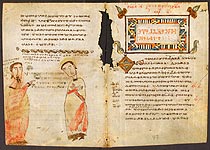Zograph Gospel. Tetraevangelion
11th century (fols. 2-40, 58-288), Old Slavonic version; 12th century (fols. 41-57) and 13th century (fols. 289-304), Middle Bulgarian version. Palimpsest (fols. 41-57): lower layer is Glagolic Tetraevangelion of 11th cent.
Q (18,0 ı 12,5 sm). II + 304 leaves. Both the beggining and the end are lost, several leaves are missing from divers parts of the codex.
Parchment (fols. 2-304), paper 12th cent. (fols. I, II, 1). Ink, cinnabar, colours.
It is written in the Glagolic alphabet (fols. 2-288) and the Cyrillic script (fols. 289r-304v - Scribe: Priest John); corrections and additions to the text are written in black and hazel ink throughout the codex).
There are 4 interlaced head-pieces with geometric motifs (fols. 77r, 129r, 131r, 225r) and tail-pieces in the form of panels, done in ink and in colours, ornamental initials (fols. 77r, 131r, 225r). The Four Gospels contain some pictures: 1) folio 43v shows the Apostles Peter and Paul; 2) folio 46v has the head of St. John the Baptist on it; 3) folio 76v bears two figures painted in ink with cinnabar and yellow colour: on the left-hand side, a man holding up his right hand in a gesture of benediction is shown, while the other with the halo round his head stands on the right, folding his arms crosswise and receiving the blessing; 4) folio 45v has a human face on it; 5) folios 52r and 53r show birds; and other later pictures.
The Zograph Gospel is one of few manuscripts in the ancient Slavonic language to have come down to us today. It is a rare example of the Glagolic codex that has survived almost completely. The decoration of the Zograph Gospel is allied with other memorials, written in the round Glagolic script, - the Codex Marianus (–√¡, √Ë„. 6) and the Assemani Gospel (Cod. Vat. Slav). Researchers mention Latin (Caroline), Coptic, Byzantine (Constantinople and South Italian) manuscripts among the sources on which the decoration system of the memorial are based.
According to a verbal legend, in ancient times the manuscript was held in the curch, governed by the Zograph Monastery, in Ierissos (a town on the isthmus, connecting the Aphon Peninsula with the continent), where since the 10th century a Bulgarian colony settled down. Then it belonged to the Zograph Monastery.
In 1860 the manuscript was presented to Emperor Alexander II by the monks of the Zograph Monastery on Mount Athos headed by Archimandrite Anfim. In 1861 it was transferred to the Imperial Public Library.
Shelfmark: –Õ¡. √Îý„. 1.
See Zograph Gospel





